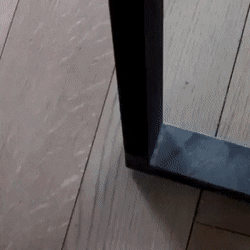Memories of the Body/Mind
Aug 17, 2020As you wander through your bedroom in the early morning, reaching for shelves that seem to shift as you approach, you realize how helpless you are without your eyesight. Instead of walking, you carefully scootch your feet step by step, hands forward like a zombie, into the inky outline of a bathroom door.
Now it may come as a ‘duh’ kind of question, but why would we do this? Why would we modify our behavior to accomplish a goal that could easily have been accomplished much faster and efficiently if we just marched right through the dark towards what we thought was the bathroom?
I’ll allow these gifs to speak for me:

We modified our behavior based on those memories of SLAMMING our toe into that damn table one too many times, just as we modify our behavior when anything incredibly painful happens to us. Remember that time you sprained your ankle when trail running? I’m sure you learned to be more careful with your steps! Remember that time you played volleyball for four hours and woke up like a train rolled over you, backed up, then body slammed you? Sure you do.
You remember. Your body remembers. And, due to these memories, we do our best to make good decisions to avoid these painful problems in the future.
The reason I’m telling you these stories is to paint a picture that our body and mind remember injuries, and that these injuries that may have occurred decades ago are still affecting our bodies today. Don’t believe me about your body remembering injuries? Research shows a good ability to predict osteoarthritis in patients decades before it occurs… the main predictor is if they’ve had a knee surgery or injury.1,2 That osteoarthritis is your body’s ‘bad memory’ of your bad night you messed up that knee. And your mind remembers injuries just fine as well… just think of one of your many injuries and I’m sure it’s as vivid as a firework on the 4th.
Growing from these painful metaphorical and literal memories is a major challenge, and that challenge is met daily with the help of proper physical therapy treatment; to reset your body’s movement and your mind’s pathologically-based control of your body in order to imprint a new patterning system that accommodates your injury. In short: Unlearn old patterns. Build new ones. Grow.
Let’s go through a typical case of how I teach my patients to build these new patterns:
Bob Smithy Jones Fake Name Jr III comes into the clinic with back pain due to paratrooping since he was 5. He’s now 31 and his lumbar spine is comprised mostly of Legos and popcorn. He likes to deadlift small horses and fight yoga instructors to pass the time, but his lower back isn’t letting him do the things he loves. Bob is desperate. He knows he has to live with this spine for the rest of his life and is concerned with what the future holds. After going through a thorough physical movement and manual assessment, I see half a dozen regions that are contributing to Bob’s pain and dysfunction.
His mechanical memories are leaping out at me from each of my assessments, and his compensations are showing me exactly how he has been subconsciously “avoiding stubbing his toe” for decades. His mental memories are evident every time he guards, takes a sharp breath, or shows hesitation when trying a new exercise. The good news is, the more time I spend with him, the more I can help him!
Breaking these movement dysfunctions down, one by one, session by session, into compartmentalized pearls of digestible information for him to relearn movement is the treatment program. Some of these memories need to be processed with manual therapy, stretching, and motor control training. Some of these memories need to be processed with a good dose of strength training. Through time, grit, and trust, these memories no longer have their teeth around the throat of Bob’s aspirations. The “memories” such as osteoarthritis will always be there, but with the dozens and dozens of pearls in his toolbox, he is able to manage and grow into a new version of his old self. He is also better able to step back and contextualize the different types of pain he feels and is less fearful of his future. This is growth.
Our mind is a powerful thing. Our bodies are equally powerful. Each of them twist together into a complex story that many times involves loss, pain, fear, and sadness. As a working clinician, I see this day in and day out, which is why I am so motivated to help my patients’ minds and bodies learn new movement memories they need to better live the lives they deserve. With work, these old movement memories are reprogrammed into a new movement system that can give a fresh capacity to the function of the previously painful and weak movement patterns.
Thanks for reading,
Marcus Rein, PT, DPT, CF-L1
- Friel, N. A., & Chu, C. R. (2013). The Role of ACL Injury in the Development of Posttraumatic Knee Osteoarthritis. Clinics in Sports Medicine, 32(1), 1-12. doi:10.1016/j.csm.2012.08.017
- Long, M. J., Papi, E., Duffell, L. D., & Mcgregor, A. H. (2017). Predicting knee osteoarthritis risk in injured populations. Clinical Biomechanics, 47, 87-95. doi:10.1016/j.clinbiomech.2017.06.001
Let us help you figure out to live your best active life today!
Remember, Movement is Medicine!

